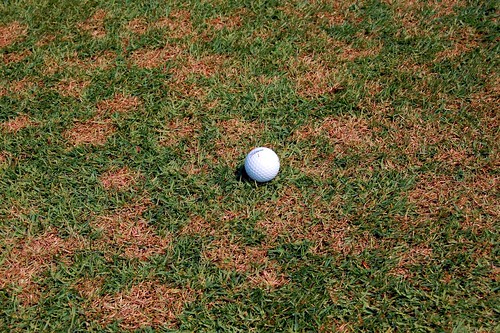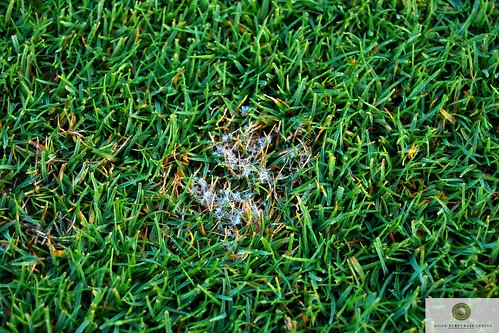snow molds
Still Wet in the West

Torrey Pines North Course #6 Putting Green (AP Photo/Chris Park)
As posted last week, California got some substantial rain and wind with southern California getting 3 to 5 inches of rain, while norcal got about 3 to 6. For us in the West, that's a lot considering our multi-year drought.
Cool season Pythium popped up in the diagnostic lab as well as rapid blight from socal and Las Vegas, which was a little surprising considering that the rain should have leached some of the sodium out of greens last week. Not surprisingly - pink snow mold was reported in both southern and northern California.
With cool temps in the 50s and 60s and scattered rain expected, we can expect more pink snow mold through out the week.
Although most California superintendents are certainly not facing the winterkill issues that our northern neighbors in Oregon and Washington are facing, annual bluegrass greens in the colder parts of the state can look pretty crappy under these cold weather conditions. Jim Alwine (Stockton Golf and Country Club) has a nice example of this on his blog post here: http://sgccturf.blogspot.com/2010/01/poa-looks-tired.html
Like Jim says, annual bluegrass can look tired and clorotic under these cold weather conditions and just refuse to grow, especially under low fertility conditions.
Trials and Tribulations (but no Tiger) at Torrey Pines
With all of that gorgeous kikuyugrass, sweet Poa greens, and a killer Rueben sandwich at the Grill & Bar, Torrey Pines Golf Course is one of my favorite places in California.
Last week's storms wreaked havoc on the course prior to this week's Farmer's Open (ex-Buick Open). With 4+ inches of rain over 5 days and 20 to 40 mph winds on Wednesday, Director of Golf, Jon Maddern and course superintendents Wayne Carpenter and Candice Combs were faced with some substantial storm damage with just a few days to get the course ready for the tournament.
http://www.10news.com/video/22319497/index.html
According to North Course Superintendent Wayne Carpenter:
We lost roughly 20 trees on the North and the South in this last storm. The soaking rains from this storm and the previous storm combined with the high wind spikes pushed over the surface rooted trees. Most of our trees have rooted on the surface for the water and because the hard sand stone keeps the roots on the surface. Almost all the trees were euc's [eucalyptus]. We only lost a couple of pines of various types. The difficulty in the clean up was all the branches, twigs, and leaves that were down everywhere. That was the tedious hand work. We couldn't do anything but put blowers out to help make piles, rake and pick up everything. The trees were a lot of work for the crew, but at least they were in one place. We could clean it up and move on. The hardest job was pumping out bunkers and restoring the faces with sand. The South lost all the sand in every face on their bunkers. The North had wash outs, but not on the scale of the Souths. I'm sure Candice can better attest to the amount of time and labor this job took on her side, but this took a huge expenditure of our crews resources. We had a number of GREAT volunteers that helped with this task and I would not have finished the North without their help. Our crews have completely worn themselves out getting this place back into shape.About 40 volunteers, including 15 staff and superintendents from golf nearby courses in the San Diego area, pitched in to help clean up the storm damage. You gotta love that collegiality and camaraderie that's present in this industry and amongst superintendents and their crews. I wonder if the public realizes how much work goes on behind the scenes to get courses ready for the big day, especially when Mother Nature deals you a bum hand.
As you can see from ESPN's coverage of the tournament today, all of that effort from Candice, Wayne and Jon, their crews and volunteers has made for some pretty sweet results:
http://espn.go.com/video/clip?id=4867407&categoryid=null
Let's hope that the rain stays away for the rest of the week so the crew at Torrey can get some well deserved rest!
By the way, Mr. Daly, it looks like you got some gray snow mold in your pants. We got some stuff that can fix that...I'm just sayin'

(AP Photo/Denis Poroy)
Thanks to Matt Marsh (Valencia Country Club) and friends for gettin' that idea in my head.
Signing Off From the Right Coast Until Next Week....
What's Cold & Wet?
Much of California, Arizona and parts of Nevada are looking pretty wet & cold right now. Conditions are about perfect for pink snow mold/Microdochium patch with daytime temps in the 50s-low60s.
Poor drainage and wet weather are perfect for pink snow mold and cool season Pythium - keep your eyes out for both of these this next week in California.
About two weeks ago, we confirmed the presence of rapid blight from a course from the big island in Hawaii on annual bluegrass. Although it's not a complete surprise considering the amount of movement (seed, golfers, tourists, etc.) between the mainland and Hawaii, it's still disconcerting considering some of the salt issues that certain Hawaiian golf courses can face. In this case, and the case of rapid blight samples from Colorado last spring, total dissolved salts were not that high. Sodium is the key salt associated with rapid blight, and although sodium is usually elevated when you have high TDS-readings, elevated sodium may not always be associated with high TDS.
(Image by Mike Goldsberry, Wing Point Golf & Country Club)
Superintendents in Western Washington and Oregon are having one hell of a time these past six months. First it was triple digit temperatures in July, Pythium outbreaks in the fall and now a lot of winterkill brought on by a week of freezing temperatures in early and late December. Drs. Gwen Stanke and Rob Golembiewski (WSU and OSU, respectively) are on top of it, but have grim forecasts for freeze affected superintendents.
http://www.ogcsa.org/email/osu-press-release-1-13.pdf
http://www.ogcsa.org/Pages/in-the-news/usga-weather-issues.html
(Hint to the blue party – you guys better get your act together after what happened in Massachusetts)
This week brings one of California's biggest charity golf events to the Coachella Valley. The Bob Hope Classic is currently being played at four courses: Nicklaus and Palmer Private Courses at PGA West (Supt. Dean Miller), La Quinta Country Club (Tim Putnam) and Silver Rock Resort (Willie Lopez), making for one of the biggest events in Coachella during the year. Watching on TV – the ryegrass fairways and rough bluegrass greens look pretty darn good for the tournament.
In addition to the celebrities, pomp and circumstance, and turfgrass (of course)…there's the 'Classic Girls' of the tournament!
http://www.bhcc.com/classic-girl.html
(For you guys on Facebook)
Here's wishing Dean, Tim & Willie a great tournament and some drier playing conditions for the rest of the week!
Dear Frank,
My home lawn is getting overrun with annual bluegrass – how do I get rid of it permanently?
Cousin Julie from Sammamish, WA
Dear Cousin Julie
If I knew how to get rid of annual bluegrass permanently, I'd be a millionaire.
Annual bluegrass management for home lawns can be difficult since homeowners don't have full access to all of the herbicides that professional pesticide applicators can use.
Some useful guidelines for homeowners can be found here: http://www.ipm.ucdavis.edu/PMG/PESTNOTES/pn7464.html
Cousin Frank
Until Next Week, Signing off From the Right Coast….
It's Conference Season
Conferences are a great way to find out the latest research results from Universities and independent researchers in your region. Organizers generally arrange for a variety of different speakers and topics ranging from disease management to weed management to cultural management practices.
Although I have only been to a few conferences so far this year (with many more to come), they have all been full of useful information for turf managers. Below are some highlights of the most recent talk I heard:
Anthracnose basal rot (Dr. Jim Murphy, Rutgers @ Eastern PA Turf Conference): Dr. Murphy summarized some of the research that he and Dr. Clarke have been working on over the past few seasons. The most surprising results are that many of the traditional recommendations provided to turfgrass managers have actually been wrong. Some findings of their work include:
- Topdressing can actually help to reduce anthracnose (presumably by burying and protecting the crown of the plant)
- Greenspeed can be maintained and anthracnose reduced by increasing N fertility and rolling instead of lowering mowing heights
- PGRs commonly used for suppressing annual bluegrass seedheads do not increase disease incidence and in certain years have decreased disease severity
- Extremes in irrigation (too much or too little) can exacerbate disease activity
To view some of the upcoming events that may be in your area, check out our calendar page.
Disease Update:
The snow has melted in many parts of the Northeast following some warmer weather revealing Microdochium patch and cool-temperature brown patch. Golf course superintendents from around the area should also be cautious about the lack of protection on the exposed turf AND also watch out for any rapid thawing/freezing of ice...especially where annual bluegrass populations are high.
As for me, I am listening to the updates of the unusually cold and snowy conditions at the British & International Golf Greenkeepers Association meeting (Harrogate) in England. Hopefully I will be able to give an International Update in the coming weeks with any useful information obtained from the meeting.
Signing off from the large island across the pond...
The Wow Factor, Seashore Paspalum and Dollar Spot
- monitor the turf growth rate and scout for dollar spot daily
- on fairways and tees, apply fast release nitrogen (sources such as ammonium sulfate, urea, or calcium nitrate work well) to stimulate growth when dollar spot infections are more than you wish to tolerate
- ensure that soil moisture levels are in an optimum range for seashore paspalum growth
- on greens, follow the same practices and use fungicides as necessary to control and prevent additional infections
Now I remember....

(image from the LA Times)
After this last week of being in the east coast, now I remember. It's in the mid 60s to mid 70s in southern California and mostly sunny. Even in chillier northern California, it's still in the 60s.
Meanwhile, Iowa is getting buried by snow, it's -50F in the Dakotas, and it's been in the 30s all week long in Alexandria VA where I've been. Even in Florida, apparently it's so cold that"Iguanas are falling out of trees."
http://abclocal.go.com/kabc/video?id=7206353&rss=rss-kabc-video-7206353
Meanwhile in the Wong Lab, it's been quiet since we're just getting back on track from being away for the winter break and mandatory furloughs. Expect rapid blight, dollar spot and Rhizoctonia large patch to be the problems of the week throughout most of California.
Question of the Week

Hey Frank,
I stumbled across an article talking about Kikuyu Yellows (Verrucalvus flavofaciens). It appears to be exactly what happended to my fairways this last summer. Have you done any research on this?
Jeff @ da' Bell
Hi Jeff -
No, I haven't heard of this - but thanks for bringing it up to my attention. Apparently this is a disease described in Australia caused by a oomycete pathogen that's pretty different from other oomycetes (like Pythium) affecting turf.
http://www.pitchcare.com.au/magazine/article/74
This disease has not been reported in the Americas as far as I know of. We haven't seen oospores in yellowing kikuyugrass roots in samples from California - but we will be on the look out since you bought it up to our attention!
I did do some searching on the internet and found this:
http://www3.interscience.wiley.com/journal/120784659/abstract
Apparently you can also get this by Googling "Kikuyugrass", "Wong" and "Dick".
That reminded me that every once in a while you should google your own name and the term "a*****e" just to make sure no one out there is really upset at you.
Ok - thanks for the info and read - good stuff that I didn't know about!
Cheers,
Frank
Signing off from the Right Coast until next week....
Brrrrrrrrrr......Allow me to introduce myself
 For those of you following Lane Tredway on the Turfgrass Disease Blog, I hate to disappoint you, but I will be guest hosting while Lane is off traipsing across the continents in search of those elusive turf pathogens. My name is Brandon Horvath, and I am a professor at the University of Tennessee in Knoxville. I was previously at Virginia Tech and located down in the Virginia Beach area, so I have been calling the transition zone my home for the last 5 years. In all seriousness, Lane will be making posts as an international blogger, since he is on his well-deserved sabbatical, and we here at the Turfgrass Disease Blog wish him safe travels.
For those of you following Lane Tredway on the Turfgrass Disease Blog, I hate to disappoint you, but I will be guest hosting while Lane is off traipsing across the continents in search of those elusive turf pathogens. My name is Brandon Horvath, and I am a professor at the University of Tennessee in Knoxville. I was previously at Virginia Tech and located down in the Virginia Beach area, so I have been calling the transition zone my home for the last 5 years. In all seriousness, Lane will be making posts as an international blogger, since he is on his well-deserved sabbatical, and we here at the Turfgrass Disease Blog wish him safe travels.Colder than a witches...
 ...well you know the rest. (Had to start with that as one of my former students at UConn heard it for the first time from her dad this past weekend).
...well you know the rest. (Had to start with that as one of my former students at UConn heard it for the first time from her dad this past weekend).Posting updates in the winter is a tough task as things are getting busier with conferences and classes start next week, but I wanted to at least provide a brief "weather report" for the region. If you want to watch the real report, you can do so here.
Since talking about turf diseases is pretty much a bust in the Northeast region at this time of the year, I thought that I would revisit some things within the website that you may not be familiar with. Here are some things that you may have missed...
- Did you know that you can view images of turf diseases in our photo gallery? Check it out here... or click on the camera logo at the top of the page.
- Want to find out what turfgrass conferences are coming up? Check it out here... or click on the calendar logo at the top of the page.
- Have you missed some updates from GCSAA? If so, you can click on the GCSAA logo and get all the latest headlines from the various departments of GCSAA on the twitter feed.

OK, that's it for the first Monday of the new year. As we progress through the year, please feel free to let us know how we can make the site better (by email or as a post in the comment...which ever works best for you).


























